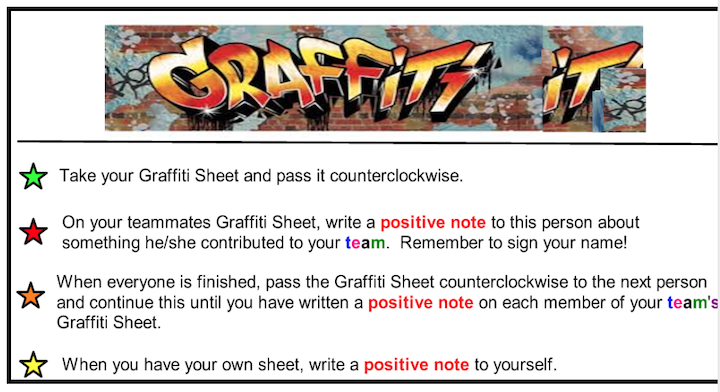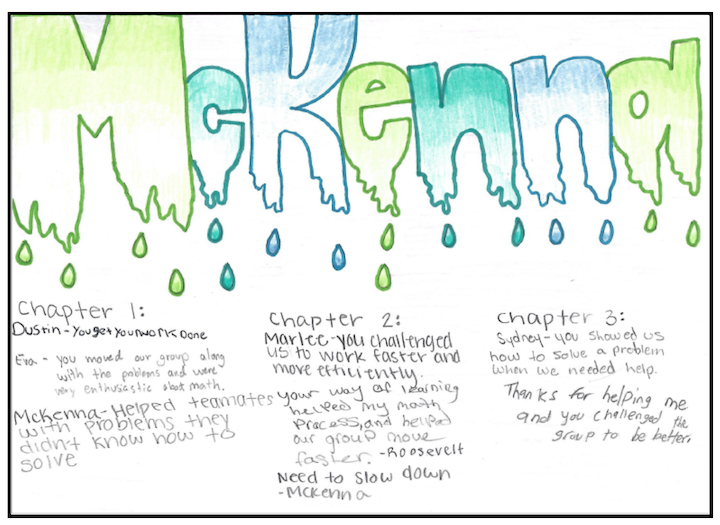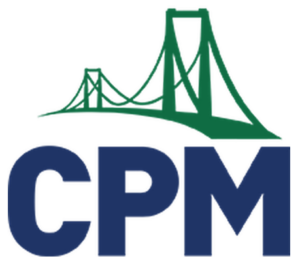Penny Smits, De Pere, WI, pennysmits@cpm.org
Study teams are at the heart of the CPM curriculum. Truly, this is the place where mathematics comes alive for students, through discourse and discovery within their teams. When a study team is working like a well-oiled machine, it is beautiful to observe. Every student has a voice and is bringing his/her strengths to the team environment. However, when a team is not working well, the mathematical experience is not the same for all members. Can we help create an environment within study teams on a daily basis so that the learning is being maximized within the classroom? How can we as teachers make students more cognizant of the impact they have on how other students feel about themselves?
In an attempt to create a more equitable math experience in the study team environment, the Graffiti It activity was conceived. After students finished the first chapter test, I had them create their own graffiti sheet, following simple instructions. Using cardstock, students were to craft their name somewhere on the page; the only parameter I placed on this was that it could not take up the entire page. They were allowed to add a design or use color if they wanted to. I made no mention of what the page was going to be used for. I was pleasantly surprised on how much detail and pride many of the students took in creating their own graffiti page. As I was walked around, I kept dreaming of all the possibilities of how this graffiti page could bring a more open and rich mathematical experience to all of my students.
Now that the groundwork for the graffiti sheets was set, students were ready for the next step. Before switching teams, I had all teams complete the Graffiti It activity. Students were to follow the directions in the box at right. The entire activity took about seven minutes to complete. I tried to restrain myself on giving students examples of what to write because I really wanted to see what they could come up with on their own. Surprisingly, students really did not ask too many questions about the activity and got down to writing positive notes to their classmates. When the activity was done, I had students thank their team members before switching to new teams.

It should be noted that students did not know that they were going to be doing this activity and as a result, they crafted positive contributions of their teammates on the spot. This is reflected in some of the earlier comments on the graffiti sheets. To help remedy this, I informed the students that they would be adding to their graffiti sheets every chapter. My thought was that it would get the students thinking more about what they personally were contributing to the team as well as what their teammates were contributing to make the learning successful for everyone.
Students have now successfully completed graffiti sheets for three chapters. As I read through the first round of graffitti sheets, I was pleasantly surprised by what students wrote. Some of them really delved into the positive contributions that their team members made to the team while others talked more about a person’s traits such as “you are nice.” I was expecting some of these types of comments since the activity was new to the students, and I had given them no warning as to what was coming. This gave me a point to discuss with my students to help them separate personality traits from those qualities that allow everyone to contribute to the study team environment in a way that was productive to all members. I wanted them to see that not a single one of us, individually, has all the abilities to solve every math problem, but that each one of us has some of the abilities that will move us closer to finding a solution.
At right is a student’s graffiti sheet. Note the positive contributions that her classmates thought that McKenna brought to the team. They were very similar to those that I noted about McKenna throughout the chapter. Another valuable insight this student learned while working with others is that she needs to slow down to allow others time to think.
Below are some other common comments that have appeared on the graffiti sheets over the past three chapters.

- “You helped me with my math when I had no clue what I was doing.”
- “You helped the team when we were confused.”
- “You challenged me to rethink the problem.”
- “You were open to different perspectives of a problem.”
- “You helped when small mistakes were made.”
- “Came to class with a positive attitude.”
- “You helped me look at the math problem differently.”
- “You made everyone think twice.”
- “Thanks for helping me with the math.”
- “I think I did good in my team because if all of us were struggling, I would still share ideas.”
- “I challenged myself.”
One of the recurring comments that continues to strike me is, “You helped me work out the answers if I didn’t know them.” Is this a key to having successful teams? The ability to show empathy for a teammate seems to be a powerful connection that many students made to their classmates. Does this help level the playing field and open the mathematics door for those who might struggle with a concept? Does this help all team members to see that it is okay to not know something or to make a mistake and be free from judgement of others? How can we foster this more?
Another powerful comment from a graffiti sheet was for a student who showed a lot of compassion for another student who was struggling. The student who struggled commented, “You were good at asking if anyone needed help.” Could simply asking a teammate if he/she needs help support the students that sometimes struggle? Does this demonstrate to others that it is okay to struggle and that they are all in this together? Was this student the voice for a teammate who was not quite ready to bring her voice to the team yet?
As students continue to use the graffiti sheets, they are helping me to see new ways to support a study team. Finding those common threads and building upon them with each study team has benefited everyone. In addition, rereading positive comments from one’s peers is a powerful way to help students feel valued as a member of the team. It also helps them to recognize their strengths and to continue to build upon them.
Creating an effective study team is imperative to everyone’s learning, but as every teacher knows, it is not an easy task. Therefore, it requires deliberate activities to help create equal status relationships within study teams. The graffiti sheet is a deliberate activity that helps foster relationships within study teams. It is a strategy that allows us to focus on things that have nothing to do with math ability, but has everything to do with inclusion within a team. Every student needs to be aware that they do not have to be a superstar in math in order to make a positive contribution to their study team. Employing the strengths of each team member collectively will enrich everyone’s mathematical experience.

